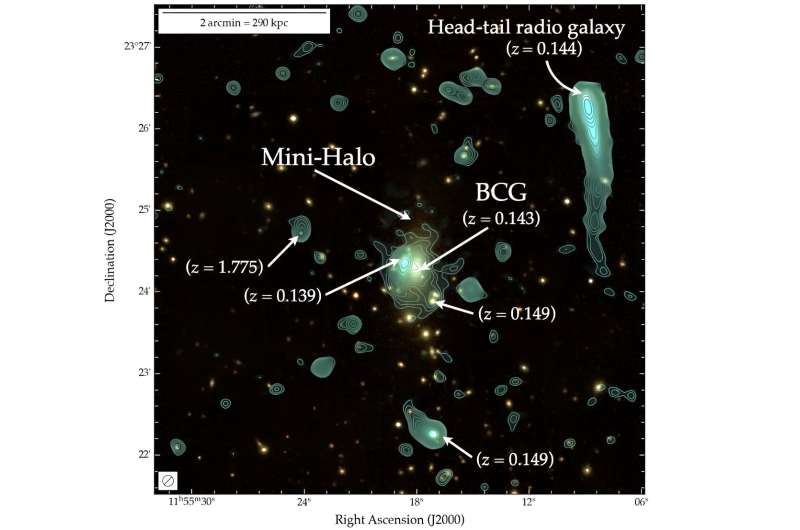August 14, 2023 report
This article has been reviewed according to Science X's editorial process and policies. Editors have highlighted the following attributes while ensuring the content's credibility:
fact-checked
peer-reviewed publication
trusted source
proofread
Radio observations inspect galaxy cluster Abell 1413

Using the LOw-Frequency ARray (LOFAR) and MeerKAT telescope, European astronomers have performed radio observations of a galaxy cluster known as Abell 1413. Results of the observational campaign, published August 1 in the Monthly Notices of the Royal Astronomical Society journal, shed more light on the properties of this cluster.
Galaxy clusters contain up to thousands of galaxies bound together by gravity. They are the largest known gravitationally bound structures in the universe, could serve as excellent laboratories for studying galaxy evolution and cosmology.
Located some 2.1 billion light years away, Abell 1413 is a type I galaxy cluster containing about 300 galaxies and hosting a mini-halo. The cluster showcases a slightly disturbed X-ray morphology, elongated in the north-south direction, however, no strong evidence of a recent merger has been found to date. The mass of Abell 1413 is estimated to be approximately 600 trillion solar masses.
A team of astronomers led by Christopher Riseley of the University of Bologna in Italy, decided to take a closer look at Abell 1413 in order to get more insights into its peculiar morphology and general properties. For this purpose they conducted deep MeerKAT observations covering the frequency range 872−1,712 MHz, and LOFAR high-band antenna (HBA) observations covering the frequency range 120−168 MHz.
"We have presented new MeerKAT L-band (1,283 MHz) and LOFAR HBA (145 MHz) observations of the galaxy cluster Abell 1413, which hosts a known mini-halo. We have combined our radio data with archival Chandra observations, enabling us to perform a detailed comparison of the thermal and non-thermal properties of this intriguing cluster," the researchers wrote in the paper.
The observations detected many compact radio sources in the vicinity of Abell 1413 and several tailed radio galaxies that are either likely or confirmed members of this cluster. Moreover, the observational campaign revealed faint and highly-extended radio emission from Abell 1413's mini-halo up to 1.9 million light years at 1,283 MHz.
Based on the collected data, it was found that the mini-halo of Abell 1413 is asymmetric and twice as large as previously thought. The team examined the spatially-resolved spectral index profile of the mini-halo, finding that its inner region appears to show a slightly flatter spectrum with a median value of −0.97, while its outer regions showcase a steeper value of approximately −1.12. These results point to spectral steepening.
The study also found that the radio/X-ray surface brightness of Abell 1413 is strongly correlated. The collected data show that the slope of this correlation is positive, with a value of 1.63 at 1,283 MHz and 1.20 at 145 MHz. This finding provides further evidence of spectral steepening.
Trying to explain the nature of the mechanism powering the mini-halo in Abell 1413, the authors of the paper offer a simple theoretical model which demonstrates that hybrid scenarios reproduce such a super-linear correlation slope that was identified in this cluster.
"While the super-linear slope is a typical signature of the hadronic scenario, our observations also support the interpretation that there is large-scale turbulence at work in Abell 1413. Hence, we investigated a simple mathematical framework which demonstrates that hybrid models—whereby secondary electrons are re-accelerated by turbulence—naturally reproduce a super-linear correlation slope in the ?R/?X plane," the researchers concluded.
More information: Christopher Riseley et al., A MeerKAT-meets-LOFAR study of Abell 1413: a moderately disturbed non-cool-core cluster hosting a ~500 kpc 'mini'-halo, Monthly Notices of the Royal Astronomical Society (2023), DOI: doi.org/10.1093/mnras/stad2218
Journal information: Monthly Notices of the Royal Astronomical Society
© 2023 Science X Network





















